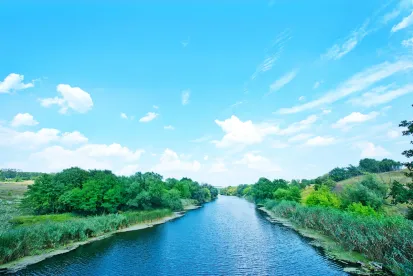US Policy and Regulatory Alert
Responding to the US Supreme Court’s landmark decision in Sackett v. EPA1, the US Environmental Protection Agency (EPA) and the US Army Corps of Engineers (Corps) published a final rule (Sackett Rule), effective September 8, 2023, defining the term “waters of the United States” (WOTUS) in the Clean Water Act (CWA).2 Notably, this is a “direct to final rule,” meaning the Agencies did not provide advanced public notice, or seek public comment on, the rule. Rather, the Agencies state that because the sole purpose of the Sackett Rule is to amend specific provisions of the WOTUS rule published in January 2023 to conform to Sackett, and such conforming amendments do not involve the exercise of the Agencies’ discretion, providing advance public notice and seeking comment was unnecessary because it would neither provide new information nor inform agency decision-making.3 The Agencies’ procedural approach, along with the substance of the rule itself, will likely be subject to future litigation as we have come to expect with any rulemaking defining WOTUS.
Consistent with the Supreme Court’s decision, the Sackett Rule substantially narrows the scope of federal jurisdiction under the CWA. Understanding the Sackett Rule and what legal “grey areas” remain will be key to successful project development moving forward. The K&L Gates Environment, Land, and Natural Resources practice group is actively engaged on these issues and helping clients understand how to comply with this rule and its effect on existing and future projects.
BACKGROUND AND CONTENTS OF THE FINAL RULE
On January 18, 2023, EPA and the Corps (the Agencies) published a final rule (2023 Rule) revising the definition of WOTUS. The 2023 Rule incorporated the “relatively permanent waters” and “significant nexus” jurisdictional tests articulated in the Supreme Court’s 2006 Rapanos decision.4 However, on May 25, 2023 the Supreme Court issued its landmark decision in Sackett v. EPA, which rendered portions of the 2023 Rule invalid by expressly rejecting the significant nexus test and substantially narrowing the scope of WOTUS as compared to the federal government’s historically broad view of its CWA authority.5
In turn, on September 8, 2023, the Agencies then published the Sackett Rule amending the 2023 Rule to conform to the Sackett decision. The Sackett Rule eliminates the “significant nexus” test from consideration when identifying tributaries, wetlands, and other waters as federally protected and clarifies that the CWA extends only to (a) relatively permanent bodies of water (such as streams, rivers, and lakes) connected to traditional navigable waters, the territorial seas, or interstate waters, and (b) wetlands that have a continuous surface connection with those waters.
In addition, the Sackett Rule clarifies that interstate wetlands do not fall within the interstate waters category (i.e., wetlands are jurisdictional only if they are “adjacent” to other jurisdictional waters or if they fall within the revised “additional waters” category). With respect to the adjacency test for identifying federally jurisdictional wetlands, “adjacent” is redefined to mean “having a continuous surface connection,” a significant departure from the Agencies’ longstanding interpretation of adjacent as meaning bordering, neighboring, or contiguous, including wetlands separated from other WOTUS by features like man-made dikes, natural river berms, and beach dunes. The Sackett Rule clarifies the types of aquatic features that are jurisdictional under the “additional waters” category: lakes and ponds, streams, and wetlands that meet both the relatively permanent waters test and that have a continuous surface connection to certain downstream waters. The 2023 Rule’s eight exclusions to the definition of WOTUS remain in place.
IMPLEMENTATION OF SACKETTRULE
Because the Sackett Rule amends portions of the 2023 Rule, the Agencies state that ongoing litigation regarding the 2023 Rule will limit where and when the Sackett Rule becomes the operative definition of WOTUS. For the 23 states and Washington, D.C., where the 2023 Rule has not been enjoined, the Agencies will implement the 2023 Rule as amended by the Sackett Rule. For the 27 states (and for certain litigants challenging the 2023 Rule) where the 2023 Rule is enjoined, the Agencies will interpret WOTUS consistent with the pre-2015 regulatory regime and the Sackett decision. The Agencies do not explain whether this dual implementation will result in a meaningful difference in how the Agencies interpret WOTUS on a project-specific basis. A map on EPA’s website, found here, shows the operative WOTUS definition in all 50 states.
WHAT COMES NEXT
The Sackett Rule recognizes a wide range of approaches the Agencies have to address possible implementation issues, including forthcoming training materials, approved jurisdictional determinations, individual permits, and even the potential for future notice and comment rulemaking. It also notes ongoing efforts to develop regionally specific tools to facilitate implementation of the WOTUS definition and coordination memoranda for use by federal agencies.
While the Sackett Rule attempts to provide a clearer test for discerning where the CWA jurisdiction ends, there remain legal “grey areas” that the Agencies and, likely, courts will need to examine. Namely, the rule does not define “relatively permanent body of water” or what constitutes a “continuous surface connection.” Moving forward it will be key to monitor how the Agencies will implement the Sackett Rule and how courts will address these open questions.
For now, the preamble to the 2023 Rule provides the best indication of the Agencies interpretation of these key phrases. The Agencies explain that relatively permanent waters encompass those with flowing or standing water year-round or continuously during certain times of the year but not those with flowing or standing water for only a short duration in direct response to precipitation. The Agencies declined to establish a minimum duration of flow because flow duration varies extensively by region (citing differences between waters in the arid west, Great Lakes region, and New England forests). The Agencies also explain that the 2023 Rule does not require that relatively permanent flow comes from a particular source (e.g., it may include groundwater sources, snow pack melt, or concentrated period of precipitation events).6
With respect to continuous surface connection, the 2023 Rule explains that it is not the same as continuous surface water connection. In other words, it does not require constant hydrologic connection; rather, it is a physical connection requirement. The Agencies explain that wetlands meet the continuous surface connection requirement if they physically abut or touch a relatively permanent water. And wetlands also meet the continuous surface connection requirement if they are connected to relatively permanent waters by a discrete feature like a nonjurisdictional ditch, swale, pipe, or culvert, because such features serve as the physical connection that maintains the continuous surface connection.7
Finally, given the substantially reduced federal scope of authority, it will be critical for project developers to understand how individual states regulate waters and wetlands within their boundaries where the scope of state jurisdiction over waters has always existed but is no longer within the scope of the CWA (as well as potential changes to state laws and regulations).
FOOTNOTES
1 For additional background on the history of waters of the United States rulemakings, guidance, and litigation, see our prior alerts: US Supreme Court Issues Landmark Clean Water Act Decision, Significantly Narrowing the Scope of “Waters of the United States” under Federal Law (Jun. 5, 2023); A New Final (But Not the Final?) WOTUS Rule (Jan. 10, 2023); EPA and Corps Release Updated Definition of Waters of the United States (Dec. 3, 2021); Back to the Drawing Board on WOTUS: Federal Court Vacates Trump Administration’s Navigable Waters Protection Rule (Sept. 20, 2021); Trump Administration Begins “Round 4” in the Battle Over Clean Water Act Jurisdiction (Jan. 14, 2019).
2 88 Fed. Reg. 61964 (Sept. 8, 2023).
3 See 88 Fed Reg. 61964-65 (citing 5 U.S.C. § 553(b)(B), which provides that, when an agency for “good cause” finds that public notice and comment procedures are “impracticable, unnecessary, or contrary to the public interest,” the agency may issue a rule without providing the public an opportunity for comment).
4 88 Fed. Reg. 3004 (Jan. 18, 2023).
5 Sackett v. EPA, 598 U.S._, 143 S. Ct. 1322 (2023); see also Rapanos v. United States, 547 U.S. 715 (2006).
6 See 88 Fed. Reg. 3004, 3084-88 (“Determining Whether a Tributary Meets the Relatively Permanent Standard”).
7 See 88 Fed. Reg. 3004, 3095-96 (“Determining Whether a Tributary Meets the Relatively Permanent Standard”).







 />i
/>i

